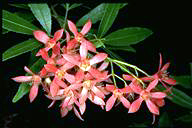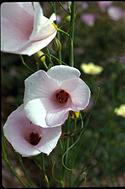

 |
Australian National Botanic Gardens
|
 |
A weekly news sheet prepared by a Gardens' volunteer.
Numbers in square brackets [] refer to garden bed Sections.
Plants in flower are in bold type.
21 January 2005
 |
|
Ceratopetalum gummiferum
- click for larger image
|
Could not miss admiring the brilliance of Eucalyptus ‘Wildfire’ [Section 174] in the garden edging Banks Walk, for this small cultivar is covered with fluffy orange flowers. Below the car park, towards the Tasmanian area, a grove of the NSW Christmas Bush, Ceratopetalum gummiferum [Section 142] is now showing some of its well-known reddened calyces which follow after the tiny white flowers. Then, turn left after crossing the lower bridge to view the Tasmanian Leatherwood, Eucryphia lucida ‘Ballerina’ [Section 142] with white flowers edged with pink, somewhat like a single rose.
This walk takes us to dryer warmer Mallee Section containing plants from SA and WA. Edging the Rainforest on the way, are hibiscus plants which include Hibiscus divaricatus [Section 114,104] with bright yellow flowers, Hibiscus splendens [Section 104] with red flowers and a taller Hibiscus heterophylus subsp. luteus [Section 114,104] with white flowers with splashes of red.
 |
|
Alyogyne hakeifolia
- click for larger image
|
Cross over now, to the road up the hill edging the old nursery. Alyogyne hakeifolia [Section 100] is a rather straggly open shrub with divided leaves and hibiscus-like deep mauve flowers. Beside, the Northern Territory floral emblem, Sturt’s Desert Rose, Gossypium sturtianum [Section 100] has rounded leaves and pinkish mauve flowers. A net bush, Calothamnus chrysantherus [Section 100] is an open shrub with red one-sided bottlebrush flowers amid the long needle foliage.
Enter the boardwalk opposite the cream papery trunk of Melaleuca decora [Section 103]. Eucalptus bennettiae [Section 100] is a small straggly tree with a few cream fluffy flowers. Eremophila bignoniiflora x polyclada [Section 100] has quite a spread with large bugle shaped white flowers, tinted mauve with dotted purple throats. Beside is a patch of Lechenaultia biloba [Section 100] with pale blue flowers and almost concealed are the bright red feathery flowers of Verticordia mitchelliana [Section 100]. Opposite, Frankenia sp. [Section 100] is a dwarf shrub bright with pink open flowers and Hypocalymma sp. [Section 100] is small and dense with clusters of pink fluffy flowers.
Past the curve Eremophila oppositifolia [Section 100] is of medium size with many curved white tubular flowers. In the center of the garden, kangaroo paw, Anigozanthos ‘Bush Glow’ [Section 100] glows with rust red ‘paw’ flowers on bare upright stems. Then Verticordia monadelpha [Section 100] is startling with vivid pink flowers. From here, in the distance, large clusters of white flowers of the tall Melaleuca decora [Section 103] can best be seen while, in the valley the white woolly flower clusters are those of a Blackthorn, Bursaria spinosa [Section 100]. Towards the valley Goodenia varia [Section 100] are small prostrate plants with yellow flowers along the trailing stems while Marianthus paralius [Section 100] is a dense ground-cover with small succulent leaves and dotted with tiny orange flowers. Lambertia ericifolila [Section 100] is a tall shrub laden with bright orange-red interesting flowers while, across the path, another prostrate plant, Hemiandra pungens [Section 100] bears its pink flowers along the trailing stems.
Good walking, great flowers …
Barbara Daly.